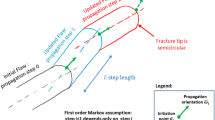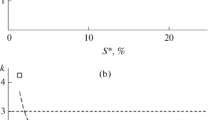Abstract
In this paper we propose a two-stage model of rock fracture. In the first stage, cracks or local regions of failure are uncorrelated and occur randomly throughout the rock in response to loading of pre-existing flaws. As damage accumulates in the rock, there is a gradual increase in the probability that large clusters of closely spaced cracks or local failure sites will develop. Based on statistical arguments, a critical density of damage will occur where clusters of flaws become large enough to lead to larger-scale failure of the rock (stage two). While crack interaction and cooperative failure is expected to occur within clusters of closely spaced cracks, the initial development of clusters is predicted based on the random variation in pre-existing flaw populations. Thus the onset of the unstable second stage in the model can be computed from the generation of random, uncorrelated damage. The proposed model incorporates notions of the kinetic (and therefore time-dependent) nature of the strength of solids as well as the discrete hierarchic structure of rocks and the flaw populations that lead to damage accumulation. The advantage offered by this model is that its salient features are valid for fracture processes occurring over a wide range of scales including earthquake processes. A notion of the rank of fracture (fracture size) is introduced, and criteria are presented for both fracture nucleation and the transition of the failure process from one scale to another.
Similar content being viewed by others
References
Albrecht, R., Schmidt, V., andBetekhtin, V. I. (1977),The Damage Process Preceding Semi-brittle Fracture in Dependence on Deformation—Part I, Phys. Statist. Sol.39, 621–630.
Atkinson, B.K. (1984),Subcritical Crack Growth in Geological Materials, J. Geophys. Res.89, 4077–4114.
Atkinson, B. K.,Fracture Mechanics of Rock, Academic Press Geology Series, (Academic Press, New York 1987).
Betekhtin, V. I., Kadomtsev, A. G., Petrov, A. I., andVladimirov, V. I. (1976),Reversibility of the First Stage of Fracture in Metals, Phys. Stat. Sol. (a)34, 73–78.
Dunning, J. D., andHuf, W. L. (1983),The Effects of Aqueous Chemical Environments on Crack and Hydraulic Fracture Propagation and Morphologies. J. Geophys. Res.88, 6491–6499.
Gor, A. Y., Kuksenko, V. S., Tomilin, N. G., andFrolov, D. I. (1989),Applicability of the Concentration Criterion to Prediction of Rock Shocks, Phys. Tech. Problems of Mining3, 54–60.
King, G. C. P., andSammis, C. G. (1992),The Mechanisms of Finite Brittle Strain, Pure Appl. Geophys.138, 611–640.
Kranz, R. L. (1980),The Effects of Confining Pressure and Stress Difference on Static Fatigue of Granite, J. Geophys. Res.85, 1854–1866.
Kuksenko, V. S., Ryskin, V. S., Betekhtin, V. I., andSlutsker, A. I. (1975),Nucleation of Submicroscopic Cracks in Stressed Solids, Internat. J. of Fracture11, 829–840.
Lockner, D. A. (1993),Room Temperature Creep in Saturated Granite, J. Geophys. Res.98, 475–487.
Lockner, D. A., Byerlee, J. D., Kuksenko, V., Ponomarev, A., andSidorin, A.,Observations of quasistatic fault growth from acoustic emissions. InFault Mechanics and Transport Properties of Rocks (Evans, B., and Wong, T.-F., eds.) (Academic Press, London 1992a) pp. 3–31.
Lockner, D. A., Moore, D. E., andReches,Z., Microcrack interaction leading to shear fracture. In33rd U.S. Rock Mechanics Symposium (Tillerson, J. R., and Wawersik, W. R., eds.) (Balkema, A. A., Rotterdam 1992b) pp. 807–816.
Lockner, D. A., andMadden, T. R. (1991a),A Multiple Crack Model of Brittle Fracture—1. Non-time-dependent Simulations, J. Geophys. Res.96, 19623–19642.
Lockner, D. A., andMadden, T. R. (1991b),A Multiple Crack Model of Brittle Fracture—2. Time-dependent Simulations, J. Geophys. Res.96, 19643–19654.
Madden, T. R. (1983),Microcrack Connectivity in Rocks: A Renormalization Group Approach to the Critical Phenomena of Conduction and Failure in Crystalline Rocks, J. Geophys. Res.88, 585–592.
Moore, D. E., andLockner, D. A. (1995),The Role of Microcracking in Shear Fracture Propagation in Granite, J. Struct. Geol.17, 95–114.
Ovchinskii, A. S., andGusev, Y. S. (1981),Computer Modeling of Damage Accumulation in Solids under Load, Sov. Phys. Solid State (English translation)23, 1921–1924.
Paterson, M.,Experimental Rock Deformation—The Brittle Field (Springer-Verlag, New York 1978).
Petrov, V. A. (1979),Mechanisms and Kinetics of Macrofracture, Soviet Phys. Solid State (English translation)21, 2123–2126.
Petrov, V. A. andOrlov, A. N. (1975),Contribution of Thermal Fluctuations to the Scattering and the Gauge Effect of Longevity, Int. J. Fract.11, 881–886.
Pollard, D. D., andSegall, P.,Theoretical displacements and stresses near fratures in rock: With applications to faults, joints, veins, dikes, and solution surfaces. InFracture Mechanics of Rock (Atkinson, B. K., ed.) (Academic Press, New York 1987), pp. 277–349.
Reches, Z., andLockner, D. A. (1994),Nucleation and Growth of Faults in Brittle Rocks, J. Geophys. Res.99, 18159–18173.
Regel, V. R., Slutcker, A. I., andTomashevskii, E. E.,Kinetic Natuare of Solids Strength (Nauka, Moscow 1974).
Sadovskiy, M. A., Golubeva, T. V., Pisarenko, V. F., andShnirman, M. G. (1984),Characteristic Dimensions of Rock and Hierarchical Properties of Seismicity, Izv. Adac. Sci., USSR, Phys. Solid Earth (in English)20, 87–96.
Sobolev, G. A., andZavialov, A. D.,A concentration criterion for seismically active faults. InEarthquake Prediction—An International Review (Am. Geophys. Union, 1981), pp. 377–380.
Sornette, D., andSammis, C. G. (1995),Complex Critical Exponents from Renormalization Theory of Earthquakes: Implications for Earthquake Predictions, J. Phys. France (in press).
Stavrogin, A. N., andPevzner, E. D. (1983),Conditions of Limiting States of Rocks in Case of Variation of Deformation Rates, Phys. Tech. Problems of Mining5, 3–11.
Stepanov, W. A., Peschanskaya, N. N., Shpeizman, V. V., andNikonov, G. A. (1975),Longevity of Solids at Complex Loading, Int. J. of Fract.11, 851–867.
Tamuzh, V. P., andKuksenko, V. S.,Fracture Micromechanics of Polymer Materials, (Martinus Nighoff Pub., The Hague, Boston, London 1981).
Tomashevskaya, I. S., andKhadimulin, Y. N. (1972),Precursors of the Destruction of Rock Specimens, Izv. Acad. Sci. USSR, Physics Solid Earth (in English)5, 276–281.
Tomashevskii, E. E., Zakrevskii, V. A., Novak, I. I., Korsukov, V. E., Regel, V. R., Pozdnyakov, O. F., Slutsker, A. I., andKuksenko, V. S. (1975),Kinetic Micromechanics of Polymer Fracture, Int. J. Fracture11, 803–815.
Weibull, W. (1989),A Statistical Theory of Strength of Materials, Ingvetensk. Acad. Handl.151, 163.
Weibull, W. (1951),A Statistical Distribution Function of Wide Applicability, J. Appl. Mech.18 293–297.
Weibull, W. (1952),A Survey of “Statistical Effects” in the Field of Material Failure, Appl. Mech. Reviews5, 449–451.
Zhu, W., David, C., andWong, T.-F. (1995),Network Modeling of Permeability Evolution during Cementation and Hot Isostatic Pressing, J. Geophys. Res. (in press).
Zhurkov, S. N. (1965),Kinetic Concept of the Strength of Solids, Int. J. Fracture Mech.1, 311–323.
Zhurkov, S. N., Kuksenko, V. S., andPetrov, V. A. (1984),Principles of the Kinetic Approach of Fracture Prediction, Theor. Appl. Frac. Mech1, 271–274.
Zhurkov, S. N., Kuksenko, V. S., Petrov, V. A., Savelyev, V. N., andSultanov, U. (1977),On the Problem of Prediction of Rock Fracture, Izv. Acad. Sci. USSR, Phys. Solid Earth (in English)13, 374–379.
Author information
Authors and Affiliations
Rights and permissions
About this article
Cite this article
Kuksenko, V., Tomilin, N., Damaskinskaya, E. et al. A two-stage model of fracture of rocks. PAGEOPH 146, 253–263 (1996). https://doi.org/10.1007/BF00876492
Received:
Accepted:
Issue Date:
DOI: https://doi.org/10.1007/BF00876492




